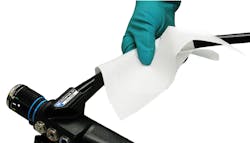Ask any Sterile Processing & Distribution (SPD) technician, supervisor, manager, director or clinical educator about the most important first step in what they do for the operating room (OR) and if they don’t recite from memory the refrain, “Cleaning, because if it’s not clean, it cannot be disinfected or sterilized,” then they might be from an alternate/parallel dimension.
But SPD professionals have long recognized how difficult and strenuous it is to clean post-procedure used devices and instruments – complex endoscopic models or otherwise – coming from the OR … particularly if those products have been enjoying a good soaking and instead are left in the open air for bioburden and organic material to gelatinize or harden into crusty scabs of tissue left behind.
Pre-treating at the point-of-use (formerly known as “pre-cleaning”) begs the following questions whose responses should be standard operating procedure industry wide.
Who’s responsible for pre-treating used devices and instruments and where? Circulating or surgical nurses in the OR? SPD techs?
How soon after a surgical procedure is completed before the used devices and instruments should undergo pre-treatment in a soak?
What materials should be used in this pre-treatment process?
Finally, who should take responsibility when these steps are not carried out?
Timing is everything
While this issue remains a sensitive one that has simmered seemingly for ages, SPD experts and leaders acknowledge that something should be done to promote safe and efficient practices and even see some headway being made.
“This is an age-old question,” Shaun Sweeney, Vice President, Cygnus Medical, told Healthcare Purchasing News. “Logic dictates that it should be done immediately following the procedure for several reasons. Mainly the efficacy of the overall process but also for preventing stainless steel pitting caused by extended contact with blood. However, the OR turnover time often takes precedence. Seeing case carts lined up in the hallway untouched is a common sight.
“Many hospitals have SPD personnel working within the OR to take over these responsibilities,” he continued. “This is a good step towards improving the process. Rinsing blood and other contaminants from the instrument as soon as possible is always the best option but is not always practical. Preventing pockets of biofilm from forming in cracks and crevices is a time-sensitive topic. It is more in the realm of minutes and hours than in days. The use of pretreating instruments with detergents is an option, but if the gel or detergent is left to dry it may create a soap film that can harbor microbes. This is an even worse outcome.
“Maintaining moisture in or around the instrument will keep the blood in a more rinsible state but water is also the one element biofilm needs to colonize. Not to mention the negative effects of stainless steel pitting and rusting still remain. In a perfect world rinsing and drying instruments after the procedure offers the greatest overall benefits,” Sweeney added.
“First and foremost, the device should be handled and cleaned according to the manufacturer’s instructions for use (IFU),” Garrett advised. “These instructions for use may dictate the timeframe for which the [pre-treatment] should take place. These instructions for use are part of the validated cleaning processes submitted by the device manufacturer to the Food and Drug Administration. Generally speaking, the sooner that [pre-treatment] and the removal of gross, organic soil can take place, the less likely the device is to form a dangerous biofilm, which can lead to patient contamination. As such, [pre-treating] at the bedside would typically be most prudent prior to transporting the device to another department.”
The paramount issue is timing, according to Ron Banach, Director of Clinical Education, Ruhof Inc.
“‘Time is of the essence’ is a critical requirement for point-of-use [pre-treating] whether Operating Room or SPD staff are assigned to the task,” Banach insisted.
“Science has proven in laboratory studies that bioburden (e.g., blood, protein, fats, carbohydrates and starches) immediately starts to dry and create a biofilm shell made of polysaccharides over the micro-organisms left on the medical device,” he noted. “In order to effectively perform the chemical treatment, it must be applied immediately after the procedure so it can solubilize the polysaccharide shell to allow the HLD or sterilization process to kill the micro-organisms.”
“We believe that [pre-treating] is critical at the point of use (POU) immediately after a procedure and prior to transport.” Willoughy told HPN. “Once instruments leave the procedure room there are too many variables that can and will delay [pre-treating] so by not using an enzymatic based [pre-treating] agent at POU immediately after a procedure is, in our view, extremely problematic.
“Although POU [pre-treating] can at times be perceived as an inconvenience in terms of time, it is still an important and a critical first step in the cycle of instrument reprocessing,” he noted. “By using [pre-treating] solutions in surgical theatres or other clinical areas conducting patient procedures, will greatly reduce the occurrence of bio-contaminants adhering to instrument surfaces. And, as simple as applying a POU [pre-treating] solution sounds – and is to do – unless this takes place at the POU the infection control chain can be broken causing the very outcomes [healthcare-associated infection] prevention polices were established to avoid and prevent.”
“Without any hesitation, the [pre-treating] step should be completed in the procedure room,” she said. “It is well known that scopes can be a challenge to clean. In fact, in 2008 the HICPAC Guidelines for disinfection and sterilization in healthcare facilities states that ‘contaminated endoscopes have been linked to more healthcare-associated infections than any other medical device.’ Not starting the cleaning process at the point of use can make it more difficult to effectively clean/sterilize instruments. Shortening the time from use to cleaning will decrease the risk of biofilm formation and increase the ease of reprocessing.”
Note the ‘golden hour’
Lemmons’ colleague, Jamie Zarembinski CCSVP, CER: Clinical Educator – Sterile Processing, Key Surgical, a STERIS company, offers the SPD perspective with some gilding.
“The goal is to reprocess the scope within the ‘golden hour,’” she said. “Most often, this means that cleaning needs to begin at the bedside. To minimize the growth of microorganisms, the length of time between patient use and delivery to decontamination needs to be as short as possible, and this time varies between facilities. In addition to reducing the time between use and cleaning, facilities should standardize their [pre-treating] process. Standardizing the workflow can reduce endoscope turnover time, improve communication and training processes between OR and SPD, and can minimize the opportunity for errors.”
“Medical device instructions for use (IFU) generally recommend pre-cleaning be performed at the end of the procedure, immediately after use, while still in the OR,” she said. “Delays in reprocessing may require additional steps in making the device patient ready and safe. In that regard, OR staff are in the best position to carry out this critical step in reprocessing as they are most aware of the ‘procedural stop time.’”
Benedict recommends this step as a standard inclusion of workflow.
“Wiping and flushing with water or detergent can easily become part of the workflow as a documented standard of care at the bedside,” she said. “The purpose of the wipe or flush is to remove heavy debris from the instrument to avoid drying of residual bioburden. Highlighting the rationale for this activity can increase user knowledge as to why the step is important and facilitate understanding of why pre-cleaning should be carried out by the OR staff who have immediate access to a device following a procedure.”
“Unfortunately, there is no simple answer to this question,” she indicated. “There are pros and cons for both scenarios, but the smart move is to follow the option posing the least risk. [Pre-treating] should be completed every time at the point of use – as soon as possible – and should involve [those] already in the room since timeliness is important. Delaying [pre-treatment] or waiting for a courier before transporting to Sterile Processing invites potential delays and other logistical questions. How many case carts are in line to be cleaned? Which ones contain endoscopes? How many Sterile Processing departments have available staff to send post-case to the Operating Room? Sterile Processing departments across the country are already struggling with personnel shortages.”
The type of device also can complicate the process for SPD, according to Kubach.
“Large diameter gastrointestinal models require cleaning steps unable to be completed without their processor/light source, bottle, tubing set-ups, valves and active suction,” she noted. “It is doubtful that a secondary tower and accessories would be housed in Sterile Processing due to cost alone.”
Kubach acknowledges that Operating Rooms have long struggled with flexible endoscope [pre-treating] requirements and compliance.
“Critical steps are often partially completed or skipped entirely. While there are many reasons for this lack of compliance, the reality is that there are many natural barriers and competing priorities that lead to ineffective [pre-treating] in the Operating Room,” she continued. “For example, a controlled sterile environment is not conducive to utilizing non-sterile liquids and detergents, especially while the patient is present. OR staff are naturally relucent to introduce the potential of a messy, contaminated process. Patient care and recovery rightfully must take priority after the procedure and post-case turnover activities may be rushed. These challenges are not easily solved for and should not be dismissed.”
But she sees room for improvement and suggests some “quick-wins” through engaging and comprehensive education.
“OR staff rarely receive formal model- or manufacturer-specific training, and most have never seen or read [pre-treating] requirements in the endoscope manufacturer’s IFU,” she said. “The greater the number of personnel involved proportionately decreases the likelihood of effective ‘hands-on’ training, especially for models with [pre-treating] procedures that are quite complex. Additional underlying factors also contribute, such as a perception that cleaning should only take place in a reprocessing area or that [pre-treating] is not important since SPD will just be cleaning it again anyway.”
POU POV
“This is a point of use function,” she said. “The scopes are delicate, intricate and expensive. The scopes generally require a quick turnaround time. Delaying the start of the cleaning process by 15 minutes allows the bioburden to begin to harden. This extends the overall cleaning time, therefore turnaround-times, and can cause possible damage to the scope to the point of taking it out of service. All delays in patient care.”
Gregg Agoston, Vice President, Business Development, SPD Transformation Services, SpecialtyCare, concurs with the location of pre-treatment and even specifies who should be responsible for doing it.
For all endoscopes, the distal end should receive particular attention, according to Agoston.
“The distal end contains the optic window and light window and in the case of some flexible endoscopes channel openings and air water nozzles,” he said. “It is very easy to run a sponge up and down the shaft of a rigid endoscope or the insertion tube of a flexible endoscope, however, the distal end is the most challenging to clean due to its small size and cervices formed by the juncture of the windows/channels.”
Agoston insists that saline solution should never be used because the salt can cause harm to components.
“For flexible endoscopes it is essential for the scrub/surgeon to follow the manufacturer’s IFU and suction water or enzymatic solution in sufficient quantities through the endoscope, and in addition, wipe down the insertion tube with water or enzymatic solution,” he continued. “One of the key concepts is that the quantity of water/enzymatic solution must be sufficient per the IFU. Often, we see clients use smaller quantities of water/enzymatic solutions (e.g., 250ml for an adult colonoscope when 500ml should be used on this device) when a greater volume is required for thorough [pre-treating].”
Accessory instruments, such as cameras, light guides and instruments, should also be wiped off with a moist towel or sponge to remove gross debris, Agoston advises.
After pre-treating in the OR, the instruments must be transported to SPD.
“To prevent drying, a towel moistened with water can be placed over the instruments and/or the instruments can be sprayed with enzymatic solution/foam designed for [pre-treating],” Agoston recommended. “As a prerequisite to using a sprayed enzymatic solution/foam, the instrument should be cleaned of all gross debris. In addition, it is very important that the enzymatic solution/foam cover the entire instrument and lumens if indicated.
Agoston urges that transport and cleaning of the instruments should occur as quickly as possible following the surgical procedure for a very logical reason: “Certain instruments require an extended processing cycle if too much time passes between the procedure and the start of the cleaning process. IFUs should always be followed,” he warned.
“In cases where it is known that processing will be delayed, there are foam products that are designed for extended hold times,” he said. “These products are specifically designed to encapsulate the flexible endoscope, keeping it moist and working to prevent the formation of biofilms for extended periods of time. When using these products, it is extremely important to follow the IFU regarding filling all channels with the product. Covering only the exterior of the endoscope is not sufficient to prevent biofilm formation in the channels.”
Editor’s Note: Due to a recent industry lexicon change, all references to “pre-cleaning” have been changed to “pre-treating” or “pre-treatment.”
Continue reading …
Pre-treatment at point-of-use ‘whodunit’
Pre-treating short cuts, task shifts can breed danger for patients
What does SPD need for endoscope reprocessing quality
All hail to the hybrids by the mid-2030s
Don’t let hang-time become a hang-up
Quality sterile processing a step-by-step process that starts in surgery
About the Author
Rick Dana Barlow
Senior Editor
Rick Dana Barlow is Senior Editor for Healthcare Purchasing News, an Endeavor Business Media publication. He can be reached at [email protected].








